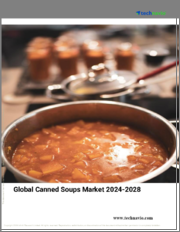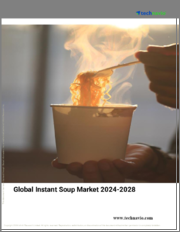
|
시장보고서
상품코드
1614959
수프 시장 규모, 점유율, 성장 분석 : 제품 유형별, 카테고리별, 포장 유형별, 유통 채널별, 지역별 - 산업 예측(2024-2031년)Soup Market Size, Share, Growth Analysis, By Product Type, By Category, By Packaging Type, By Distribution Channel, By Region - Industry Forecast 2024-2031 |
||||||
수프 세계 시장 규모는 2022년 161억 2,000만 달러로 평가되며, 2023년 167억 2,000만 달러에서 2031년 223억 5,000만 달러로 성장하여 예측 기간(2024-2031년) 동안 3.7%의 CAGR로 성장할 것으로 예상됩니다.
수프 시장은 패스트푸드에 대한 수요 증가와 단백질, 비타민, 미네랄을 함유한 수프의 건강 효과에 대한 인식이 높아짐에 따라 눈에 띄게 성장하고 있습니다. 이러한 추세는 소비자의 라이프스타일이 건강한 식습관으로 변화함에 따라 앞으로도 계속될 것으로 예상됩니다. 도시화, 가처분 소득 증가, 혁신적인 맛의 도입 등이 세계 수프 수요에 기여하는 요인으로 꼽힙니다. 특히 중국, 인도 등 아시아태평양 국가를 중심으로 한 신흥국들의 도시로의 이주가 이러한 추세를 더욱 가속화시키고 있습니다. 건조 수프는 영양가가 높고 외식보다 편리하다는 장점으로 시장을 주도하고 있습니다. 그러나 일부 제품은 나트륨 함량이 높아 성장에 걸림돌이 될 수 있습니다. 북미와 유럽은 바쁜 라이프스타일로 인해 통조림 식품 소비가 활발하게 이루어지고 있으며, 생산자들은 건강 지향적인 새로운 맛과 제품에 초점을 맞추고 있습니다.
목차
소개
- 조사 목적
- 조사 범위
- 정의
조사 방법
- 정보 조달
- 2차 데이터와 1차 데이터 방법
- 시장 규모 예측
- 시장 가정과 제한
주요 요약
- 세계 시장 전망
- 공급과 수요 동향 분석
- 부문별 기회 분석
시장 역학과 전망
- 시장 개요
- 시장 규모
- 시장 역학
- 성장 촉진요인과 기회
- 성장 억제요인과 과제
- Porters 분석과 영향
- 경쟁 기업 간의 경쟁 관계
- 대체품의 위협
- 구매자의 교섭력
- 신규 참여업체의 위협
- 공급 기업의 교섭력
주요 시장 인사이트
- 핵심성공요인
- 경쟁 정도
- 주요 투자 기회
- 시장 생태계
- 시장 매력 지수(2023년)
- PESTEL 분석
- 거시경제 지표
- 밸류체인 분석
- 가격 분석
- 규제 상황
- 특허 분석
- 사례 연구
- 고객과 구매 기준 분석
수프 시장 규모 : 제품 유형별 & CAGR(2024-2031년)
- 시장 개요
- 보존용 수프
- 냉장 수프
- 건조 수프
- 냉동 수프
- 인스턴트 수프
- UHT(초고온) 수프
수프 시장 규모 : 카테고리별 & CAGR(2024-2031년)
- 시장 개요
- 베지테리언 수프
- 비베지테리언 수프
수프 시장 규모 : 포장 유형별 & CAGR(2024-2031년)
- 시장 개요
- 통조림
- 파우치
- 기타
수프 시장 규모 : 유통 채널별 & CAGR(2024-2031년)
- 시장 개요
- 오프라인
- 슈퍼마켓
- 편의점
- 전문점
- 약국
- 온라인
- E-Commerce 웹사이트
- 회사 소유 웹사이트
수프 시장 규모 & CAGR(2024-2031년)
- 북미
- 미국
- 캐나다
- 유럽
- 영국
- 독일
- 스페인
- 프랑스
- 이탈리아
- 기타 유럽
- 아시아태평양
- 중국
- 인도
- 일본
- 한국
- 기타 아시아태평양
- 라틴아메리카
- 브라질
- 기타 라틴아메리카
- 중동 및 아프리카
- GCC 국가
- 남아프리카공화국
- 기타 중동 및 아프리카
경쟁 정보
- 상위 5개사의 비교
- 주요 기업의 시장 포지셔닝(2023년)
- 주요 시장 기업이 채용한 전략
- 시장의 최근 동향
- 기업의 시장 점유율 분석(2023년)
- 주요 기업 개요
- 기업 개요
- 제품 포트폴리오 분석
- 부문별 점유율 분석
- 매출 전년비 비교(2021-2023년)
주요 기업 개요
- Campbell Soup Company
- Nestle S.A.
- Unilever
- General Mills, Inc.
- Kraft Heinz Company
- Conagra Brands, Inc.
- B&G Foods, Inc.
- Premier Foods Group Limited
- Amy's Kitchen, Inc.
- Baxters Food Group Limited
- Blount Fine Foods
- Hain Celestial Group, Inc.
- Bear Creek Country Kitchens, LLC
- Kettle Cuisine, LLC
- TSC Foods
- Associated British Foods PLC
- Nissin Foods Holdings Co., Ltd.
- Maruchan, Inc.
- Ottogi Corporation
- Ajinomoto Co., Inc.
결론과 추천사항
ksm 25.01.20Global Soup Market size was valued at USD 16.12 billion in 2022 and is poised to grow from USD 16.72 billion in 2023 to USD 22.35 billion by 2031, growing at a CAGR of 3.7% during the forecast period (2024-2031).
The soup market is experiencing notable growth, driven by rising demand for fast food and increased awareness of soups' health benefits, including their protein, vitamin, and mineral content. This trend is expected to continue as consumer lifestyles shift toward healthier eating. Factors contributing to global soup demand include urbanization, rising disposable incomes, and innovative flavor introductions. Urban migration in developing regions, especially in Asia-Pacific countries like China and India, is further amplifying this trend. Dried soups are leading the market due to their superior nutritional value and convenience over restaurant offerings. However, high sodium levels in some products may hinder growth. North America and Europe exhibit strong consumption of canned foods, driven by busy lifestyles, prompting producers to focus on health-oriented new flavors and offerings.
Top-down and bottom-up approaches were used to estimate and validate the size of the Global Soup market and to estimate the size of various other dependent submarkets. The research methodology used to estimate the market size includes the following details: The key players in the market were identified through secondary research, and their market shares in the respective regions were determined through primary and secondary research. This entire procedure includes the study of the annual and financial reports of the top market players and extensive interviews for key insights from industry leaders such as CEOs, VPs, directors, and marketing executives. All percentage shares split, and breakdowns were determined using secondary sources and verified through Primary sources. All possible parameters that affect the markets covered in this research study have been accounted for, viewed in extensive detail, verified through primary research, and analyzed to get the final quantitative and qualitative data.
Global Soup Market Segmental Analysis
Global Soup Market is segmented by Product Type, Category, Packaging Type, Distribution Channel and Region. Based on product type, the market is segmented into preserved soup, chilled soup, dehydrated soup, frozen soup, instant soup and UHT (ultra-high temperature) soup. Based on category, the market is segmented into vegetarian soup and non-vegetarian soup. Based on packaging type, the market is segmented into canned, pouched and others. Based on distribution channel, the market is segmented into offline (supermarkets, convenience stores, specialty stores, pharmacies) and online (e-commerce websites, company-owned websites). Based on region, the market is segmented into North America, Europe, Asia Pacific, Latin America and Middle East & Africa.
Driver of the Global Soup Market
The global soup market is witnessing significant growth driven by the increasing demand for convenience foods. This surge is largely influenced by the rising vegan demographic in both developed and developing regions, prompting major manufacturers to produce a variety of vegan soups in multiple packaging formats. Consumers are increasingly opting for nutritious vegetable soups over traditional non-vegetarian options, reflecting a broader trend towards health-conscious eating habits. Additionally, the quest for dietary variety is leading to a growing appetite for instant soup products. Differences in regional cuisines also encourage producers to innovate with new flavors and packaging designs, ensuring that diverse consumer preferences are catered to, thus further fueling market expansion.
Restraints in the Global Soup Market
The global soup market faces several restraints primarily due to the rising health concerns associated with high levels of thickening agents like salt and cornstarch, which are commonly found in many products, particularly canned and dehydrated soups. Regular consumption of these ingredients has been linked to obesity, hypertension, and diabetes, prompting consumers, especially in health-conscious countries like Japan, to scrutinize food additives more closely. This heightened awareness restricts market growth as customers seek healthier alternatives. In response, leading manufacturers are innovating by reducing corn starch content and incorporating more vegetables into their recipes. For instance, Campbell Soup Company has expanded its offerings to include a range of vegetable flavors such as carrot and ginger, specifically targeting the younger demographic that is increasingly knowledgeable about nutrition labels and ingredient healthfulness.
Market Trends of the Global Soup Market
The global soup market is witnessing a significant trend driven by the growing demand for convenience foods, attributed to increasing urbanization and the fast-paced lifestyles of consumers. This surge in demand has fostered a diverse range of soup offerings, including ready-to-eat (RTE) and ready-to-drink (RTD) varieties, catering to the needs of busy individuals seeking quick meal solutions. As consumers prioritize convenience without sacrificing flavor or nutrition, brands are innovating to enhance product accessibility and appeal, such as offering gourmet flavors and health-conscious options. Consequently, the soup segment is poised for strong growth, reflecting broader trends in the convenience food industry.
Table of Contents
Introduction
- Objectives of the Study
- Scope of the Report
- Definitions
Research Methodology
- Information Procurement
- Secondary & Primary Data Methods
- Market Size Estimation
- Market Assumptions & Limitations
Executive Summary
- Global Market Outlook
- Supply & Demand Trend Analysis
- Segmental Opportunity Analysis
Market Dynamics & Outlook
- Market Overview
- Market Size
- Market Dynamics
- Driver & Opportunities
- Restraints & Challenges
- Porters Analysis & Impact
- Competitive rivalry
- Threat of substitute
- Bargaining power of buyers
- Threat of new entrants
- Bargaining power of suppliers
Key Market Insights
- Key Success Factors
- Degree of Competition
- Top Investment Pockets
- Market Ecosystem
- Market Attractiveness Index, 2023
- PESTEL Analysis
- Macro-Economic Indicators
- Value Chain Analysis
- Pricing Analysis
- Regulatory Landscape
- Patent Analysis
- Case Studies
- Customer & Buying Criteria Analysis
Global Soup Market Size by Product Type & CAGR (2024-2031)
- Market Overview
- Preserved Soup
- Chilled Soup
- Dehydrated Soup
- Frozen Soup
- Instant Soup
- UHT (Ultra-High Temperature) Soup
Global Soup Market Size by Category & CAGR (2024-2031)
- Market Overview
- Vegetarian Soup
- Non-Vegetarian Soup
Global Soup Market Size by Packaging Type & CAGR (2024-2031)
- Market Overview
- Canned
- Pouched
- Others
Global Soup Market Size by Distribution Channel & CAGR (2024-2031)
- Market Overview
- Offline
- Supermarkets
- Convenience Stores
- Specialty Stores
- Pharmacies
- Online
- E-commerce Websites
- Company-Owned Websites
Global Soup Market Size & CAGR (2024-2031)
- North America (Product Type, Category, Packaging Type, Distribution Channel)
- US
- Canada
- Europe (Product Type, Category, Packaging Type, Distribution Channel)
- UK
- Germany
- Spain
- France
- Italy
- Rest of Europe
- Asia-Pacific (Product Type, Category, Packaging Type, Distribution Channel)
- China
- India
- Japan
- South Korea
- Rest of Asia Pacific
- Latin America (Product Type, Category, Packaging Type, Distribution Channel)
- Brazil
- Rest of Latin America
- Middle East & Africa (Product Type, Category, Packaging Type, Distribution Channel)
- GCC Countries
- South Africa
- Rest of Middle East & Africa
Competitive Intelligence
- Top 5 Player Comparison
- Market Positioning of Key Players, 2023
- Strategies Adopted by Key Market Players
- Recent Developments in the Market
- Company Market Share Analysis, 2023
- Company Profiles of All Key Players
- Company Details
- Product Portfolio Analysis
- Company's Segmental Share Analysis
- Revenue Y-O-Y Comparison (2021-2023)
Key Company Profiles
- Campbell Soup Company
- Company Overview
- Business Segment Overview
- Financial Updates
- Key Developments
- Nestle S.A.
- Company Overview
- Business Segment Overview
- Financial Updates
- Key Developments
- Unilever
- Company Overview
- Business Segment Overview
- Financial Updates
- Key Developments
- General Mills, Inc.
- Company Overview
- Business Segment Overview
- Financial Updates
- Key Developments
- Kraft Heinz Company
- Company Overview
- Business Segment Overview
- Financial Updates
- Key Developments
- Conagra Brands, Inc.
- Company Overview
- Business Segment Overview
- Financial Updates
- Key Developments
- B&G Foods, Inc.
- Company Overview
- Business Segment Overview
- Financial Updates
- Key Developments
- Premier Foods Group Limited
- Company Overview
- Business Segment Overview
- Financial Updates
- Key Developments
- Amy's Kitchen, Inc.
- Company Overview
- Business Segment Overview
- Financial Updates
- Key Developments
- Baxters Food Group Limited
- Company Overview
- Business Segment Overview
- Financial Updates
- Key Developments
- Blount Fine Foods
- Company Overview
- Business Segment Overview
- Financial Updates
- Key Developments
- Hain Celestial Group, Inc.
- Company Overview
- Business Segment Overview
- Financial Updates
- Key Developments
- Bear Creek Country Kitchens, LLC
- Company Overview
- Business Segment Overview
- Financial Updates
- Key Developments
- Kettle Cuisine, LLC
- Company Overview
- Business Segment Overview
- Financial Updates
- Key Developments
- TSC Foods
- Company Overview
- Business Segment Overview
- Financial Updates
- Key Developments
- Associated British Foods PLC
- Company Overview
- Business Segment Overview
- Financial Updates
- Key Developments
- Nissin Foods Holdings Co., Ltd.
- Company Overview
- Business Segment Overview
- Financial Updates
- Key Developments
- Maruchan, Inc.
- Company Overview
- Business Segment Overview
- Financial Updates
- Key Developments
- Ottogi Corporation
- Company Overview
- Business Segment Overview
- Financial Updates
- Key Developments
- Ajinomoto Co., Inc.
- Company Overview
- Business Segment Overview
- Financial Updates
- Key Developments



















